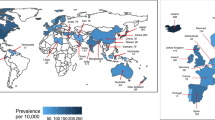Abstract
Variations of season of birth among autistic individuals were studied. The replicability of previously reported increases in birth rates in the months of March and August were examined in groups of individuals with autism or mental retardation (the comparison group). The sample was obtained from the Yale Child Study Center Developmental Disabilities Clinic and from the DSM-IV Autism/PDD field trial. Data were analyzed by applying the Jonckheere test of ordinal trend and the chi-square test, with Yates correction factor. With respect to March and August births, and with calculations based on the beginning and middle of the month, no significant seasonal effect was observed. Samples were subcategorized into verbal and mute groups, and again results failed to support the seasonality hypothesis.
Similar content being viewed by others
REFERENCES
American Psychiatric Association. (1980). Diagnostic and statistical manual of mental disorders (3rd ed.). Washington, DC: Author.
American Psychiatric Association. (1987). Diagnostic and statistical manual of mental disorders (3rd ed., Rev.). Washington, DC: Author.
American Psychiatric Association. (1994). Diagnostic and statistical manual of mental disorders (4th ed). Washington, DC: Author.
Barak, Y., Ring, A., Sulkes, J., Cabbaj, U, & Elizur, A. (1995). Season of birth and autistic disorders in Israel. American Journal of Psychiatry, 152, 798–800.
Bartlik, B. D. (1981). Monthly variation in births of autistic children in North Carolina. Journal of the American Medical Women's Association, 36, 363–368.
Bolton, P., & Rutter, M. (1990). Genetic influences in autism. International Review of Psychiatry, 2, 67–80.
Bolton, P., Pickles, A., Harrington, R., Macdonald, H., & Rutter, M. (1992). Season of birth: Issues, approaches and findings for autism. Journal of Child Psychology and Psychiatry, 33, 509–530.
Boyd, J., Pulver, A., & Stewart, W. (1986). Season of birth: Schizophrenia and bipolar disorder. Schizophrenia Bulletin, 12, 173–185.
Bradbury, T., & Milles, G. (1985). Season of birth in schizophrenia: A review of evidence, methodology and aetiology. Psychology Bulletin, 98, 569–594.
Cicchetti, D. V., Showalter, D., Fuerst, D., and Rourke, B. P. (1992). A computer program for analyzing ordinal trends with dichotomous outcomes: Application to neuropsychological research. Clinical Neuropsychologist, 6, 458–463.
Coleman, M. (1987). Neurological subgroups in autism. In E. Schopler & G. Mesibov (Eds.), Neurobiological issues in autism (pp. 163–178). New York: Plenum Press.
Dalen, P. (1975). Season of birth: A study of schizophrenia and other mental disorders. Amsterdam: Elsevier/North Holland.
Dyer, R. E., Runreich, A., & Badger, L. F. (1931). Typhus fever: A virus of the Typhus type derived from fleas collected from wild rats. Public Health Reports, 96, 334–338.
Fleiss, J. L. (1981) Statistical methods for rates and proportions (2nd ed.). New York: Wiley.
Folstein, S., & Rutter, M. (1977). Infantile autism: A genetic study of 21 twin pairs. Journal of Child Psychology and Psychiatry, 18, 297–321.
Fombonne, E. (1989). Season of birth and childhood psychosis. British Journal of Psychiatry, 155, 655–661.
Gillberg, C. (1988). The neurobiology of infantile autism. Journal of Child Psychology and Psychiatry, 29, 257–266.
Gillberg, C. (1990). Do children with autism have March birthdays? Acta Psychiatrica Scandinavica, 82, 152–156.
Gillberg, C., Ohlson, V., Wahlstrom, J., Steffenburg, S., & Blix, K. (1988). Monozygotic female twins with autism and the fragile-X syndrome (AFRAX). Journal of Child Psychology and Psychiatry, 29, 447–451.
Hare, E. H. (1975). Manic-depressive psychosis and season of birth. Acta Psychiatrica Scandinavica, 52, 69–79.
Jonckheere, A. R. (1970). Techniques for ordered contingency tables. In J. B. Riemersma & H. C. van der Meer (Eds.), Proceedings of the NUFFIC International Summer Session in Science “Het Oude Hof,” The Hague.
Kaufman, A. S., & Kaufman, N. L. (1983). Kaufman Assessment Battery for Children. Circle Pines, MN: American Guidance Service.
Konstantareas, M., Hauser, P., Lenox, C., & Homatidis, S. (1986). Season of birth in infantile autism. Child Psychiatry and Human Development, 17, 53–65.
Krug, D. A., Arick, J. R., & Almond, P. G. (1980). Behavior checklist for identifying severely handicapped individuals with high levels of autistic behavior. Journal of Child Psychology and Psychiatry, 21, 221–229.
Leach, C. (1979). Introduction to statistics: A nonparametric approach for the social sciences. New York: Wiley.
LeCouteur, A., Rutter, M., Lord, C., Rios, P., Robertson, S., Holdgrafer, M., & McLennan, J. (1989). Autism diagnostic interview: A standardized investigator-based instrument. Journal of Autism and Developmental Disorders, 19, 363–387.
Maxcy, K. (1926). An epidemiological study of endemic typhus (Brill's disease) in the southeastern United States with special reference to its mode of transmission. Public Health Reports, 41, 1967–1995.
Moundsen, E., Nielson, S., Rich, B., & Isages, T. (1994). Season of birth in infantile autism and other types of childhood psychoses. Child Psychiatry and Human Development, 25, 31–43.
Nielsen, J., Bruun Petersen, G., & Therkelsen, A. J. (1973). Seasonal variation in the birth of children with aneuploid chromosomal abnormalities. Human Genetics, 19, 67–70.
Roszkowski, M. (1980). Season of birth and degree of mental retardation: Failure to confirm a relationship. Psychology Reports 47, 100–102.
Rutter, M. (1970). Autistic children: Infancy to adulthood. Seminars in Psychiatry, 2, 435–450.
Tanove, Y., Oda, S., Asano, F., & Kawashima, K. (1988). Epidemiology of infantile autism in southern Ibraki, Japan: Differences in prevalence in birth cohorts. Journal of Autism and Developmental Disorders, 18, 155–166.
Terman, L. M., & Merrill, M. A. (1960). Stanford-Binet Intelligence Scale. Boston: Houghton Mifflin.
Torrey, E. F., Bowler, A. E., Rawlings, R., & Terrazas, A. (1993). Seasonality of schizophrenia and stillbirths. Schizophrenia, Bulletin, 19, 557–562.
Volkmar, F., Klin, A., Siegel, B., et al. (1994). Field trial for autistic disorder in DSM-IV. American Journal of Psychiatry, 151, 1361–1367.
World Health Organization. (1978). Mental disorders: Glossary and guide to their classification in accordance with the ninth revision of the International classification of diseases. Geneva, Switzerland: Author.
World Health Organization. (1990). International classification of disease (10th rev.). Draft Chapter. Geneva, Switzerland: Author.
Author information
Authors and Affiliations
Corresponding author
Rights and permissions
About this article
Cite this article
Landau, E.C., Cicchetti, D.V., Klin, A. et al. Season of Birth in Autism: A Fiction Revisited. J Autism Dev Disord 29, 385–393 (1999). https://doi.org/10.1023/A:1023030911527
Issue Date:
DOI: https://doi.org/10.1023/A:1023030911527




